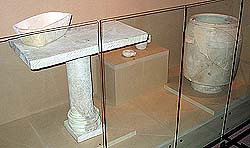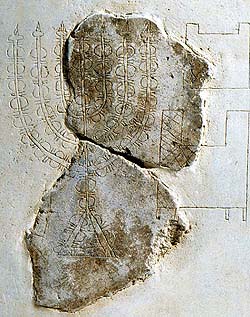 |
||||||||||||||||


|
|
THE SECOND TEMPLE PERIODIn the Sumptuous Residences of Nobles and PriestsIn the Second Temple period, the rich people of Jerusalem lived on the western hill, or the upper city as it was called at the time-the present Jewish quarter in the old city. The view of the Temple must have been superb, as the homes themselves must have been, with mosaics on the floors, frescoes on the walls and fine furnishings. A large number of stone vessels have been found in the remains of these vast residences, and in simpler homes as well. This has to do with the strict observance of ritual purity demanded by the Torah. For unlike pottery, wood or metal containers, stone ones could not be contaminated. At this time, many workshops in Jerusalem produced stone furniture, ossuaries and dishes. Representation of the MenorahThis piece of incised plaster illustrated below bears the oldest known representation of the menorah, the seven-armed candelabrum that stood in the Second Temple in King Herod's day. It was found during archaeological digs in what is now the Jewish quarter of the old city of Jerusalem. This image was actually made when the menorah was still in the Temple-and thus by someone who had seen the menorah-perhaps one of the priests.
|
 |
|||||||||||||
 |
||||||||||||||||


